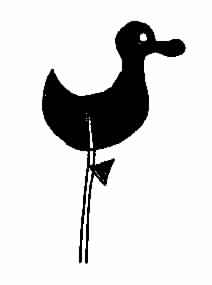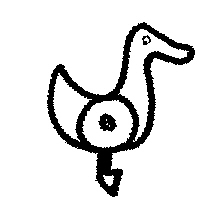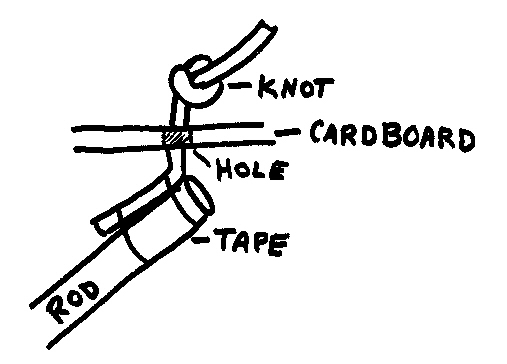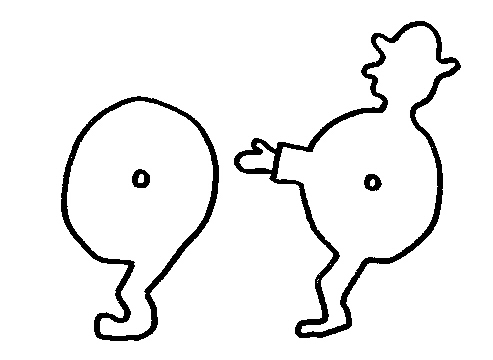
Shadow Puppets and Their Presentation
Shadow puppets are a mysterious and wonderful kind of puppet. If you have ever made hand shadows (used your hands to make shadows that look like animals, etc.) on the wall or have seen shadows cast by a flashlight on a camping tent wall then you already have an idea of how shadow puppets work. What you need to create the magic of shadow puppets is a screen on which to project the shadows (-light must be able to pass through it--it could be a sheet, tent wall, big piece of paper, etc.) a light source (could be the sun or an artificial light --flourescent lights do not work well) and a shadow puppet (an object that will cast its shadow on the screen.) Here is how it works:
The light must shine onto the screen; then anything placed between the light and the screen will cast a shadow onto the screen.

drawing by Stephanie Holdermann
Fig. 1 Note that the light shines onto the back of the screen, showing the shadow of the puppet (held by the puppeteer) while the audience watches from the front of the screen, seeing only the projected shadow. Shadow puppets are best viewed in the dark!
Notice in the picture that the audience watches the show from the other side of the screen. They don't see the puppets, they just see the shadows of the puppets (that's why they call it shadow puppets!)
Making Your Shadow Puppets
What you will need:
Heavy construction paper or thin cardboard (like a cereal box) or file folder type material
paper (to plan your design on) & pencil
scissors
hole punch
brass brads
sticks for the controllers (chop sticks, coathanger wire, popsicle sticks, or bamboo skewers)
glue or tape (to attach the control sticks) or string (for a moving control stick, see below)
black paint or marker (optional) if your cardboard is not a dark color
Let's get started!
First you must decide just what kind of character you want to make. Although you can make anything you want, let's try a duck just to get started. For the simplest of shadow puppets you can draw a picture of a duck on your planning paper, transfer the design to the cardboard, and cut it out and paste it to a stick. (When you are drawing the duck, remember that all your audience will see of the duck is the shadow, so any details you draw on the puppet will not show.)

Figure 2. A simple duck cut out of cardboard with a stick glued on with which to hold it. Note that the stick (shown white) also becomes the duck's leg (helping to hide the stick in the shadow.) To make the eye you can cut a hole in the puppet head so that the light shines through (remember, if you just draw an eye, it won't show on the shadow!)
Now, let's say you want to make some part of your duck move. You are ready for lesson 2 in making shadow puppets. In order to make a moving part for your shadow puppet, you have to make that part separate from the rest of the puppet. Let's take our duck example and give him some movement. Take your piece of paper and draw your duck outline again. Then make a copy of your duck onto another piece of paper (you can use tracing paper, carbon paper, or just cut out your duck while holding two pieces of paper together, so that you cut 2 ducks at once. Let's decide now what parts we want to move. Let's make this duck have a wiggly walk. To do so, we will make the duck in 2 pieces, with the front half of the duck separate from the back half. Part of each "half" of the puppet must overlap the other "half" with a pivot in the middle (this is where the brads come in handy.) Let's draw our overlap in the form of a circle on our duck drawings. (see figure 3)

Figure 3 shows the circle with the center hole marked that will be the overlapping pieces of your shadow puppet. When you cut them out, each half of the duck will include the whole circle with the hole (see figure 4, below). Transfer the two pieces to the cardboard and cut them out.

Figure 4 shows the two pieces of the duck puppet, each with the circle and hole, now cut out of the cardboard and ready to assemble. Poke your brad through the holes of both pieces and you have a whole duck again, but one in which the front half and back half can rotate independently from each other on the brad.
Now you are ready to attach the controls on your moving duck puppet. In the first duck (the non moving one) we attached one stick. For the moving duck we will need 2 rods to control it, one to hold the front half of the duck steady and one to make the back half of the duck move up and down for the wiggly walk. You can attach the first control rod to the leg and foot (and body) of the front half of the duck, just like in the first puppet. Next you want to connect the second control rod to the back half of the duck. This rod must be attached somewhere behind the pivot point (so when you move it, it pushes up on the back half of the duck, causing it to raise up. It is good (though not necessary) to attach this rear control rod so that it will pivot. Instead of gluing the rod directly to the cardboard, you can poke a hole in the cardboard and push a string through it. Tie a knot in one end of the string so that it will not pass back through the hole, and then attach the other end of the string to the rod (you can use glue or tape.)

Figure 5 shows a closeup of the knot on one side of the puppet half, and the rod on the other. This gives you a nice, movable rod connection. Don't leave too much slack between the knot and the rod and you will have a nice, tight control.
Now, while holding the forward control still in one hand, use the other hand to move the rear control up and down. It should give your puppet a fun walking motion. Now do that while moving the puppet forward on your shadow screen. Your puppet walks.
Once you have the idea of how to design your shadow puppets you can make all kinds of different puppets with different movements. Even just using 2 pieces to make your puppets you can make a great variety of fun puppets. Use your imagination to make different parts move. For example you could make a man puppet and have one leg and one arm move together (shadow puppets don't have to be realistic!)
Now, look at the drawing below and see if you can predict what kind of movement you would get if you attached these two pieces together and attached the rods. What if you made the "moving" part be the leg and the "still" part be the part with the head and arm? Or, what if you made the leg part be the still part and make the head, arm and other leg be the moving part? Which would be funnier?

Figure 6 - An example of a funny shadow puppet. In shadow puppetry you are limited only by your imagination! Go make some fun puppets!
Some final tips:
Use the paint in the materials list to color your puppet black (or a dark color). You will get a better shadow that way.
If you can not see your shadow puppet well when it is held in the light, try holding it right up against the screen. Some light sources make crisper shadows than others. (The rule about lights is the smaller the light bulb filament, and the brighter, the better the shadow. Quartz bulbs work well, but experiment until you find the light effect you want.)
To make a colored shadow you can use tissue paper over a cut out part of the puppet (for example, you can cover the duck's eye with yellow tissue and even draw in an eyeball with black marker on the yellow tissue.)
To make scenery, cut out the silouettes of your scenery and tape, pin or otherwise attach it to your shadow screen.
LINKS
A great site for more information on making shadow theaters and puppets: http://www.osv.org/kids/crafts2.htm
Another site with shadow puppet making info; http://family.go.com/crafts/sew/feature/famf19puppet/famf19puppet5.html